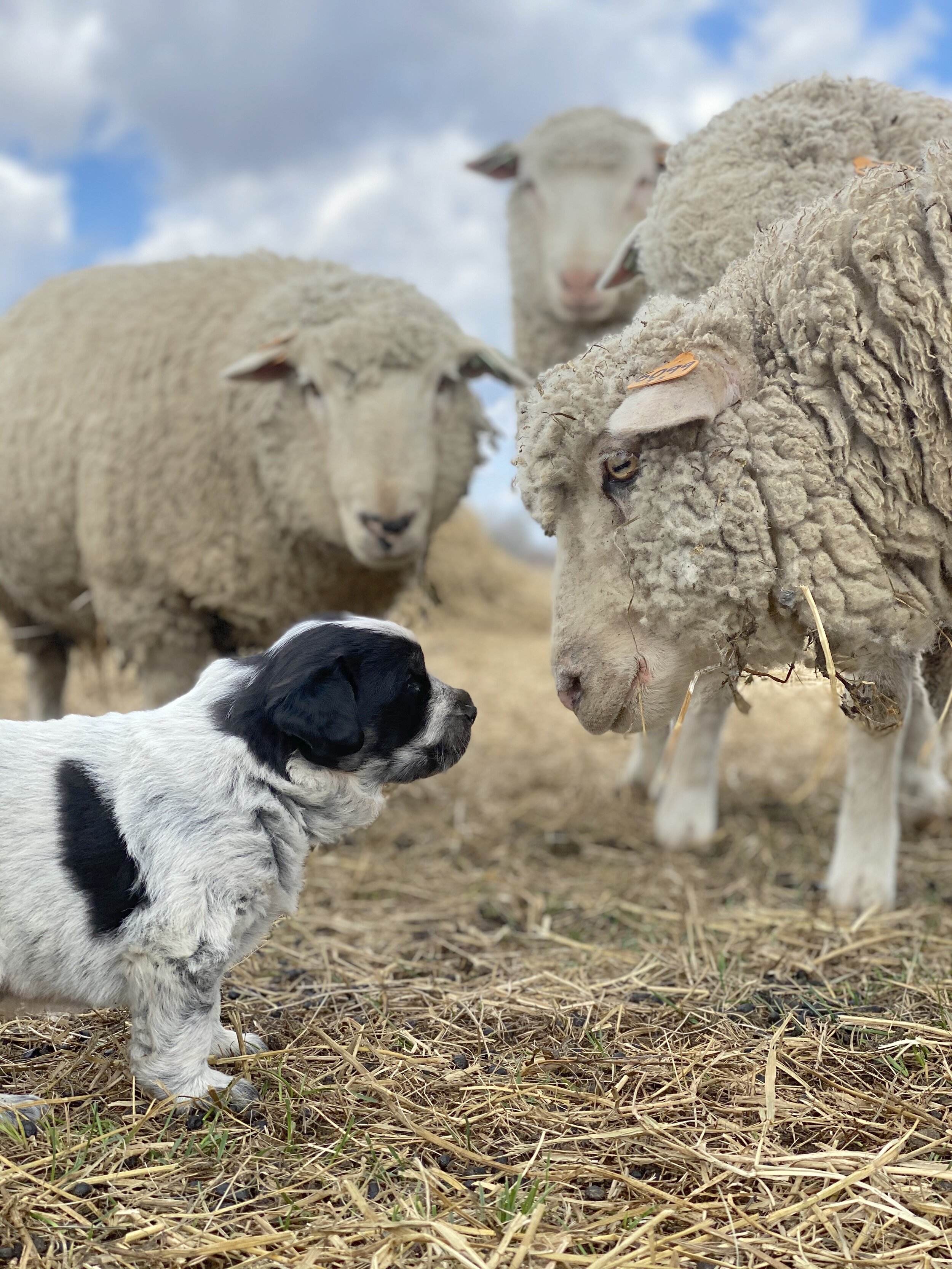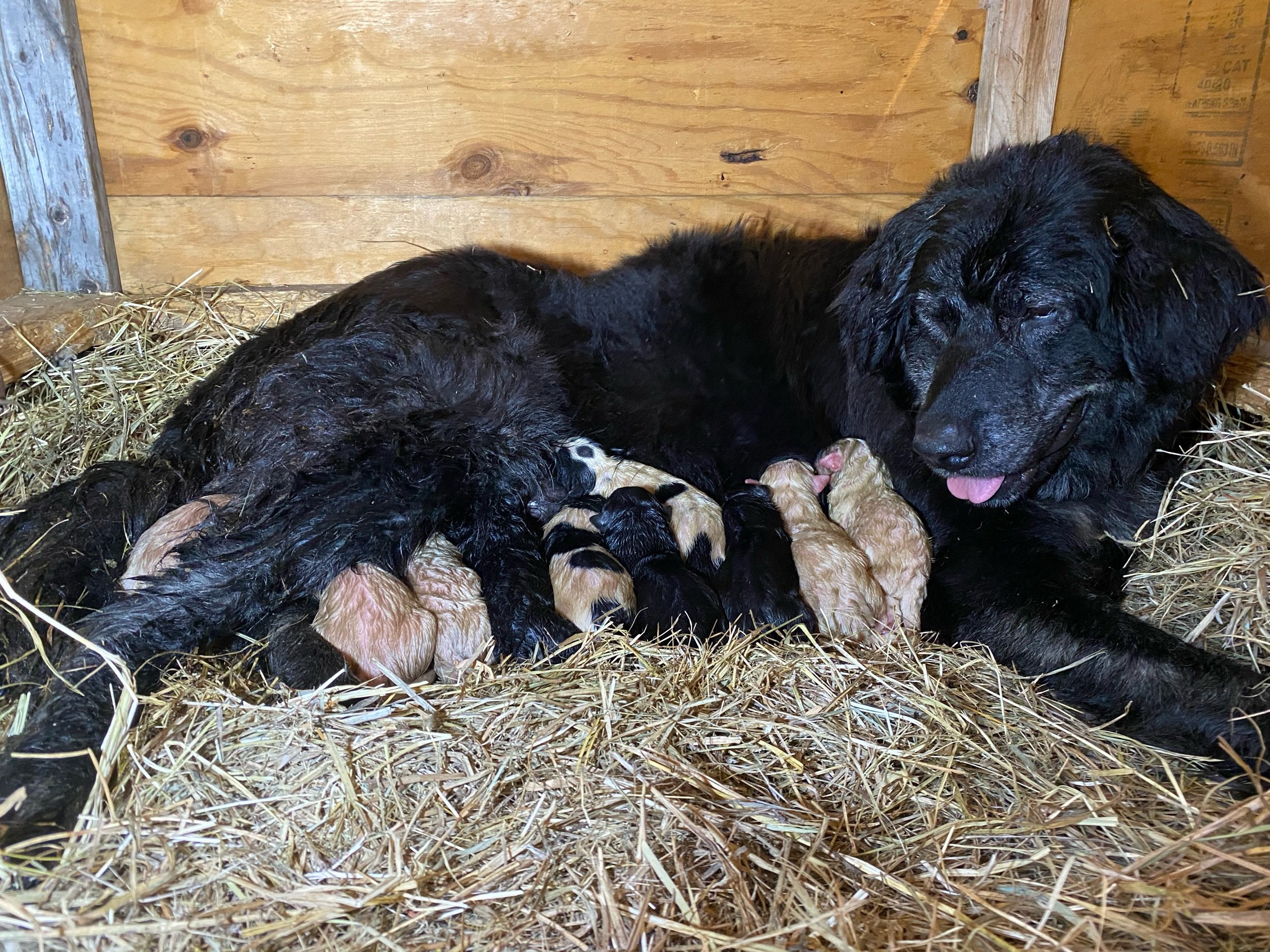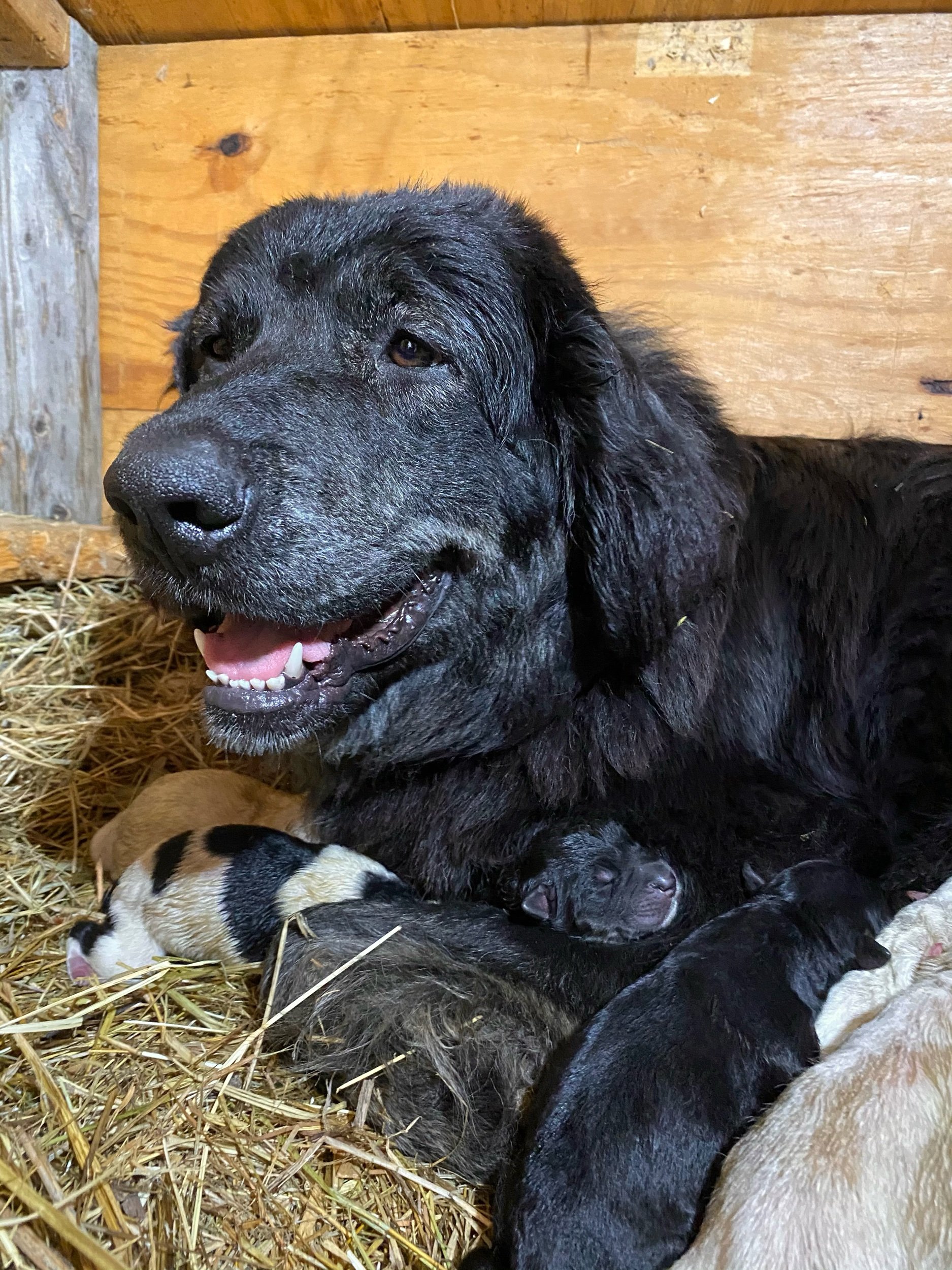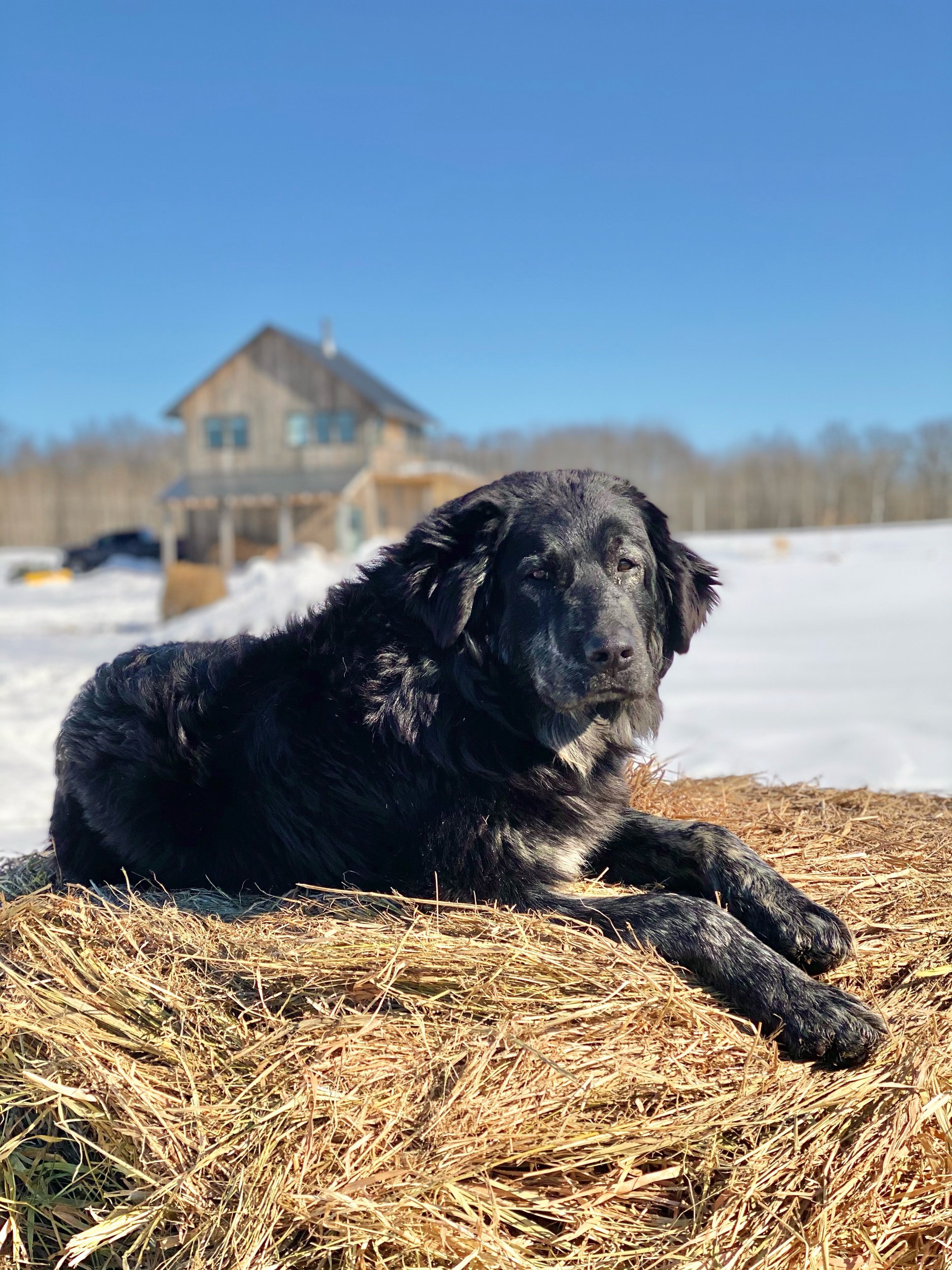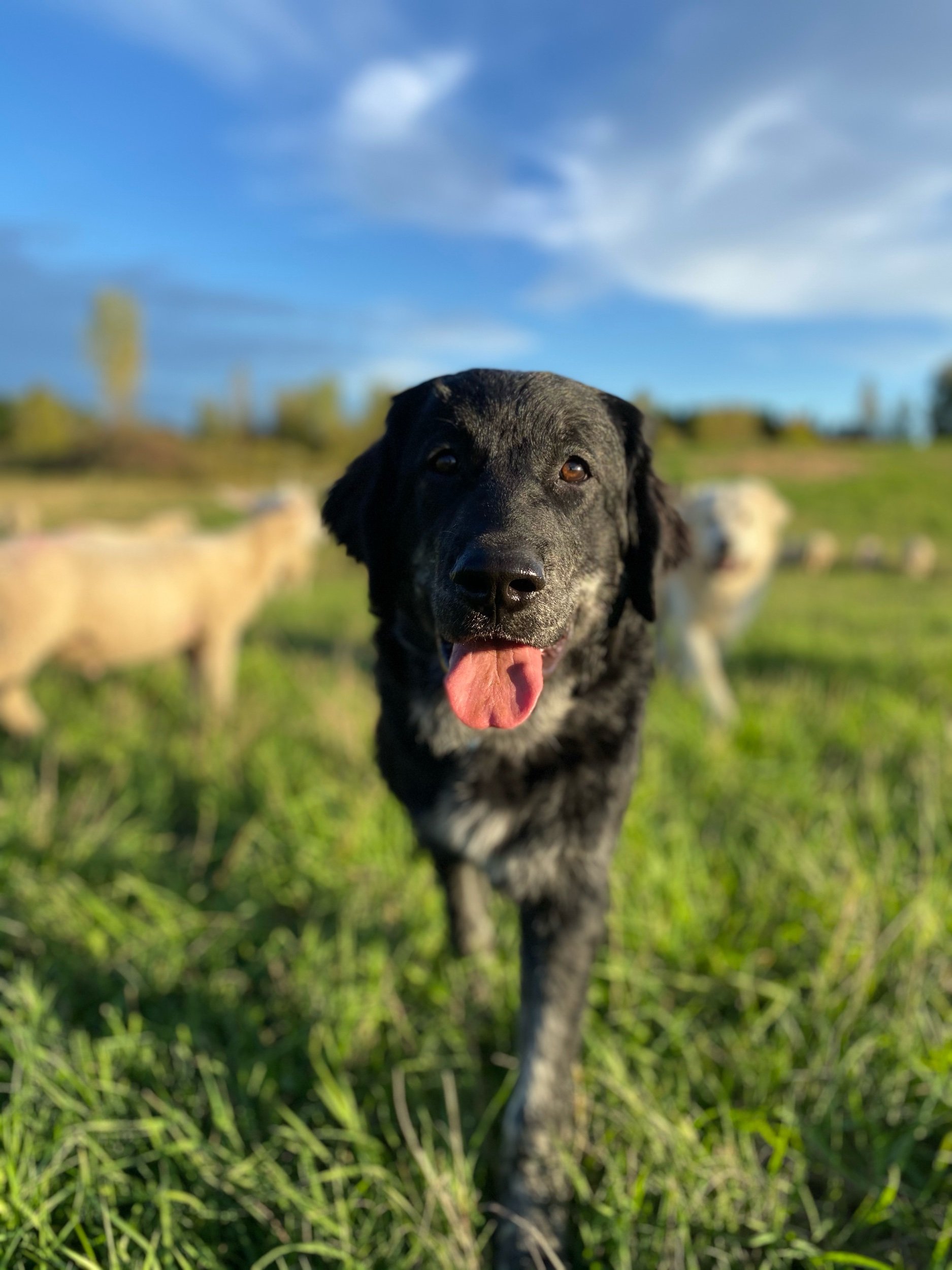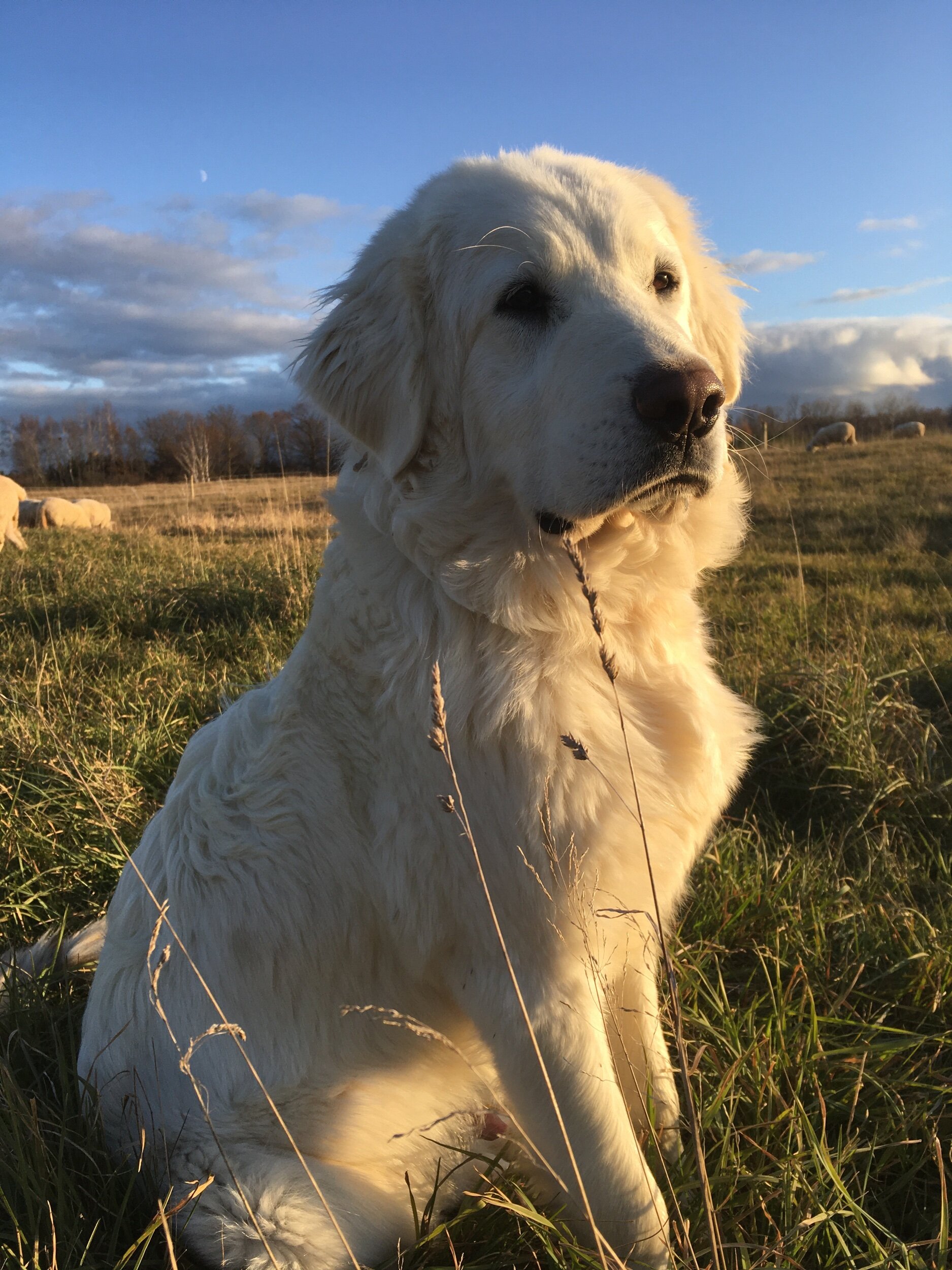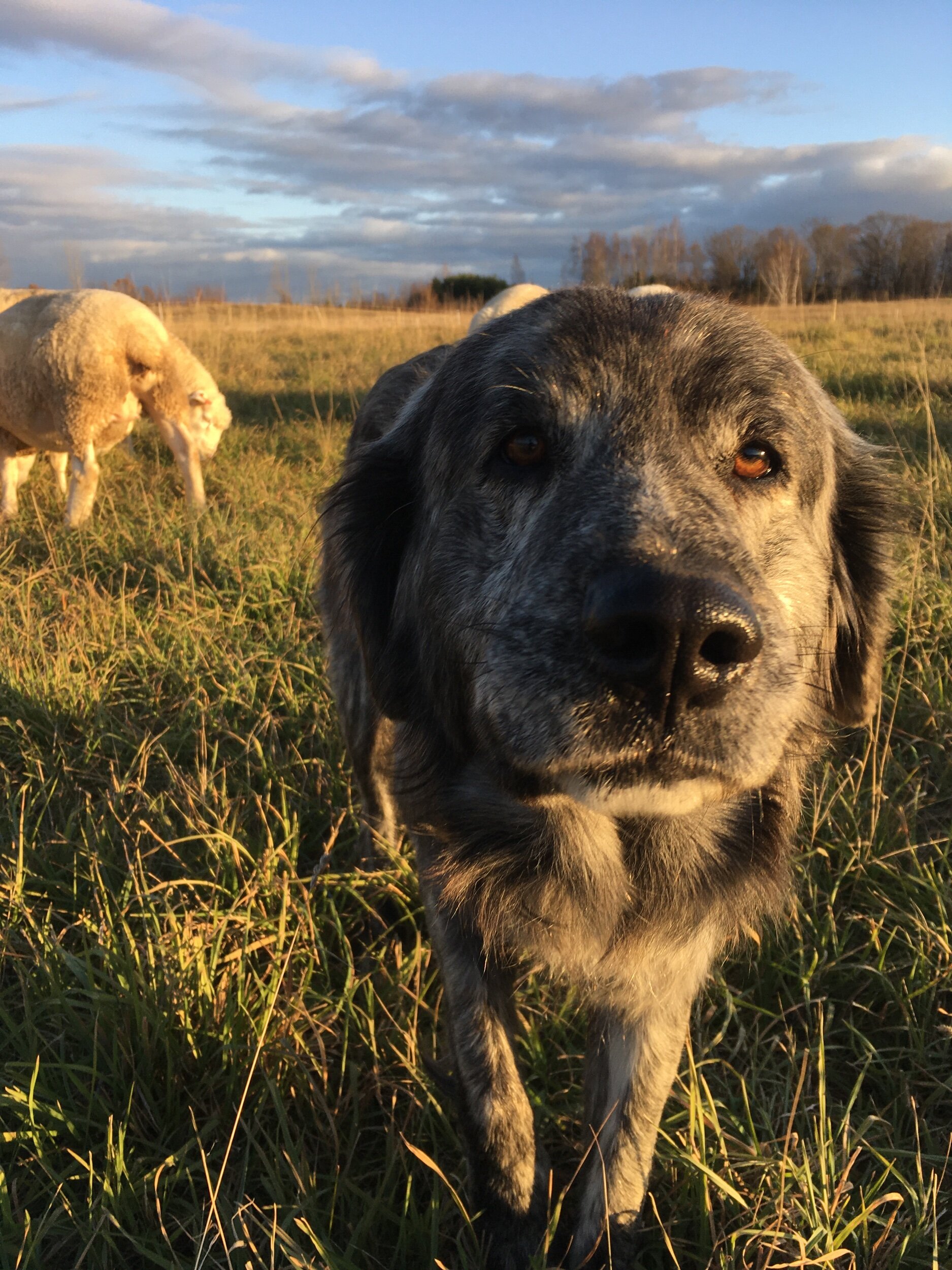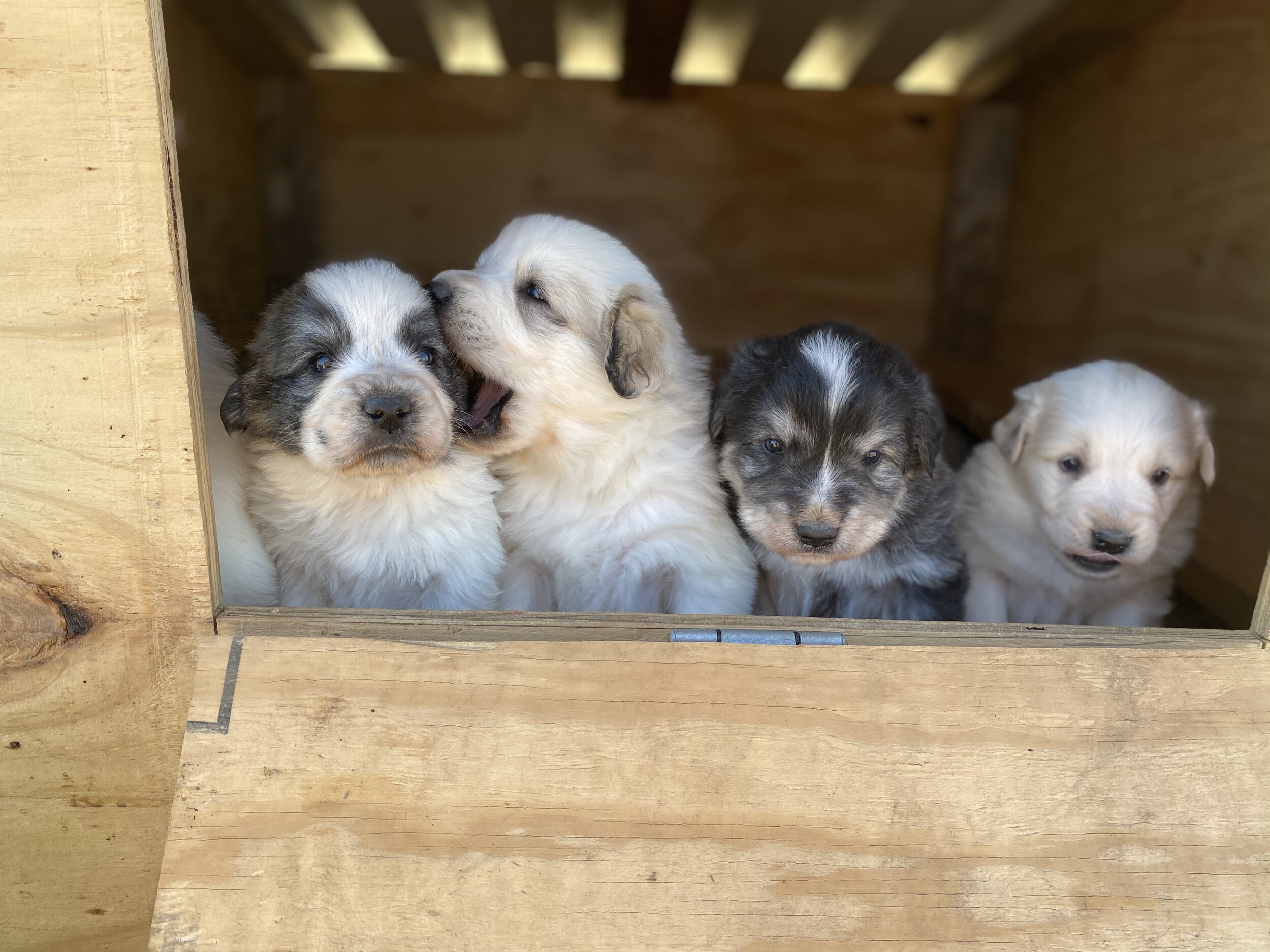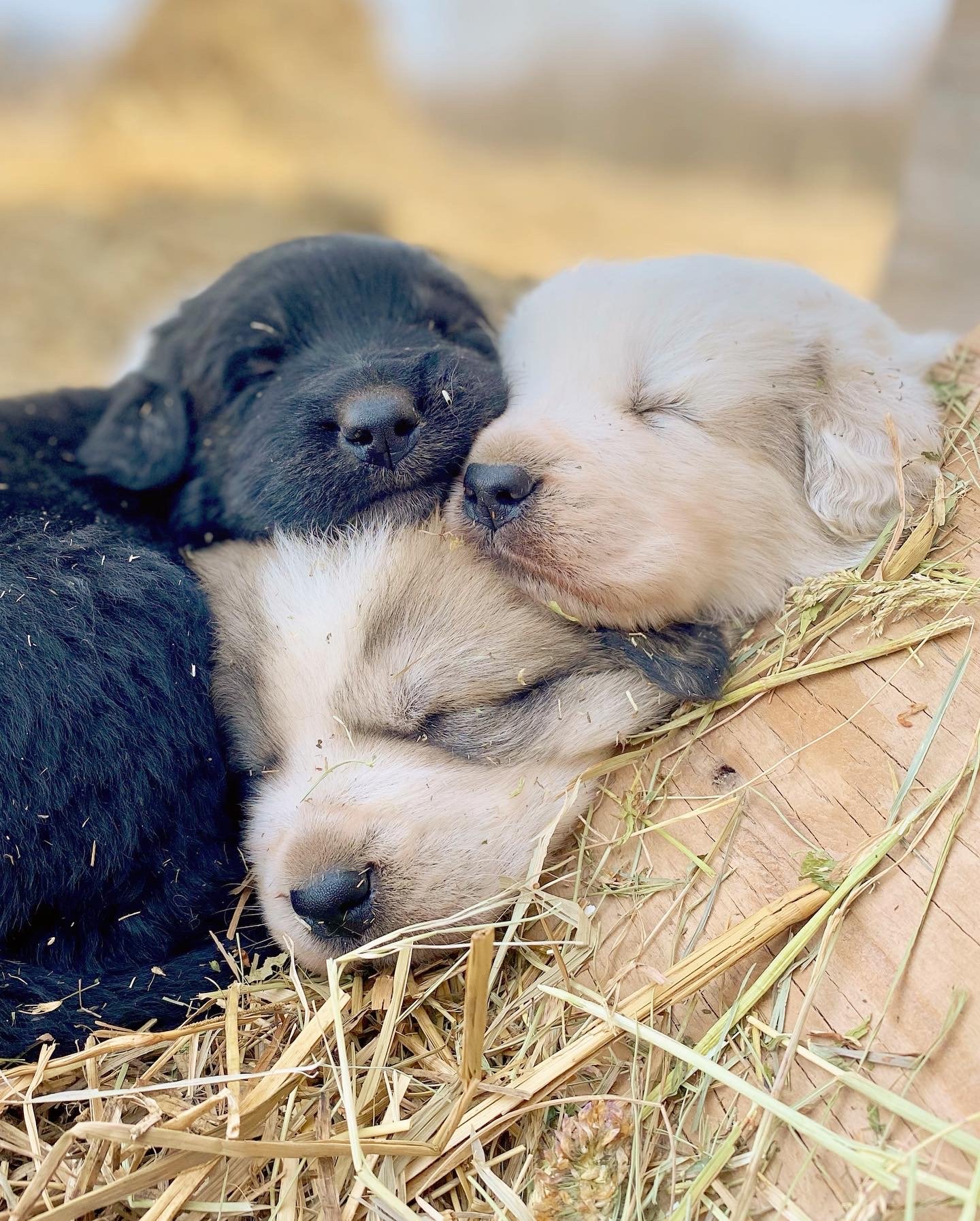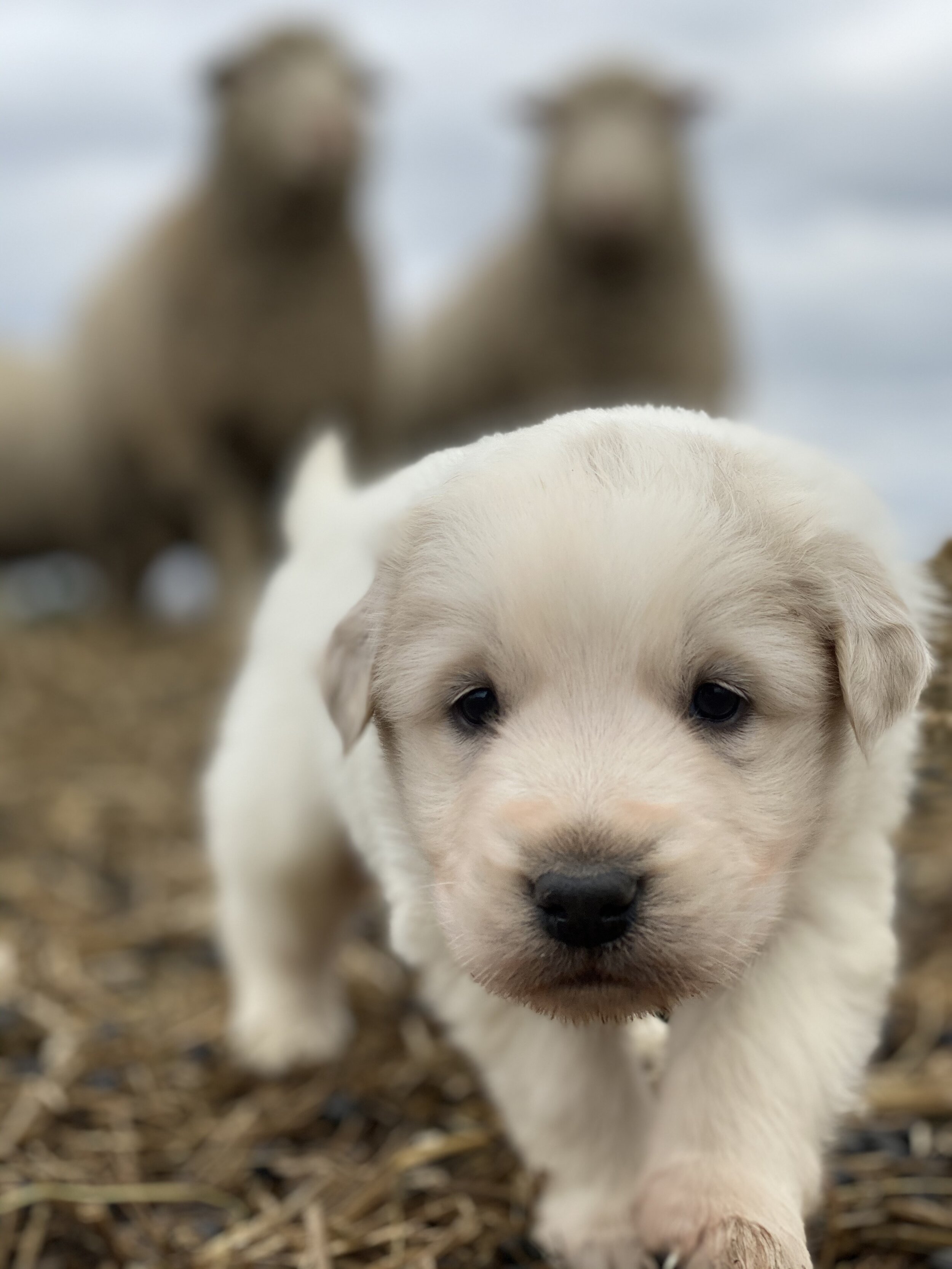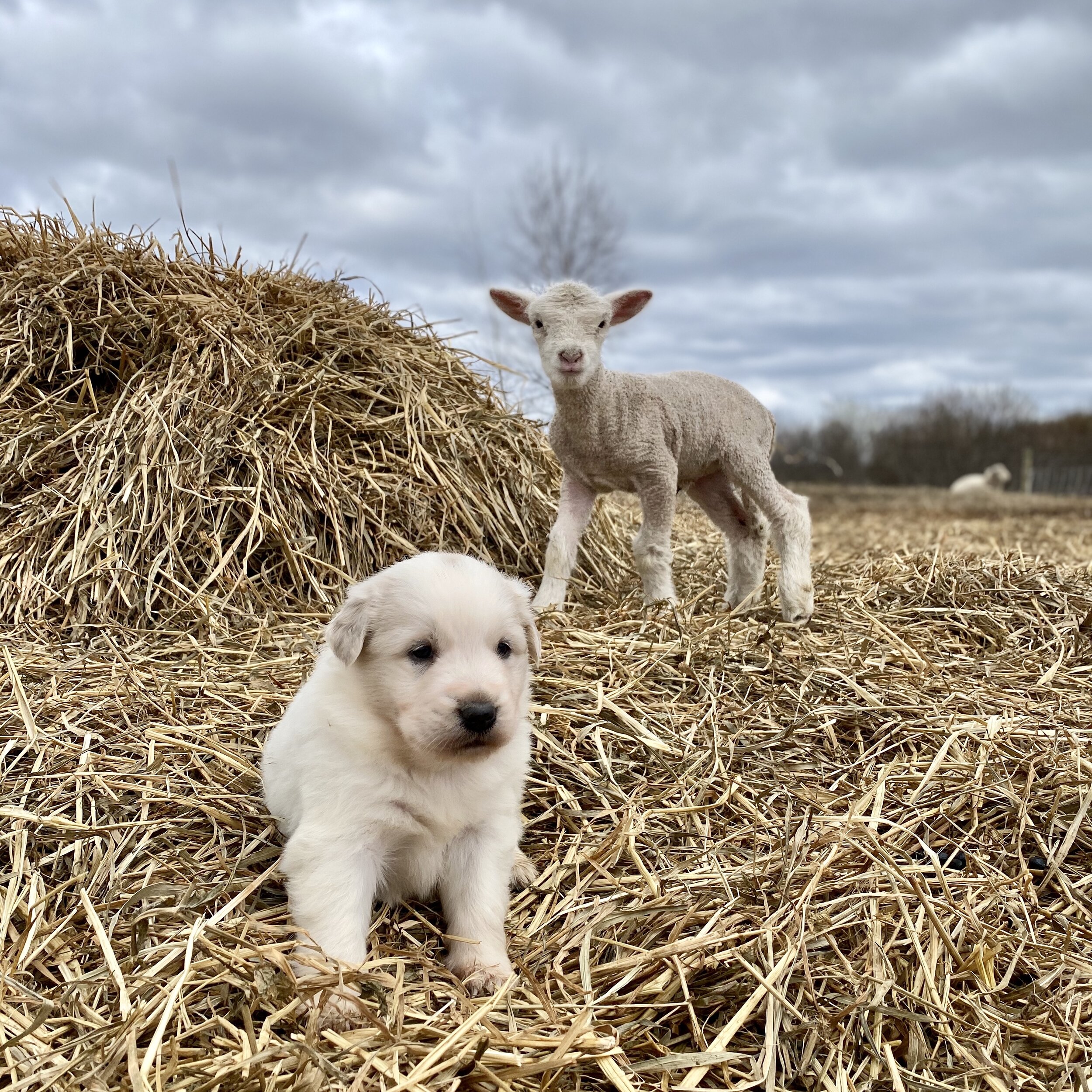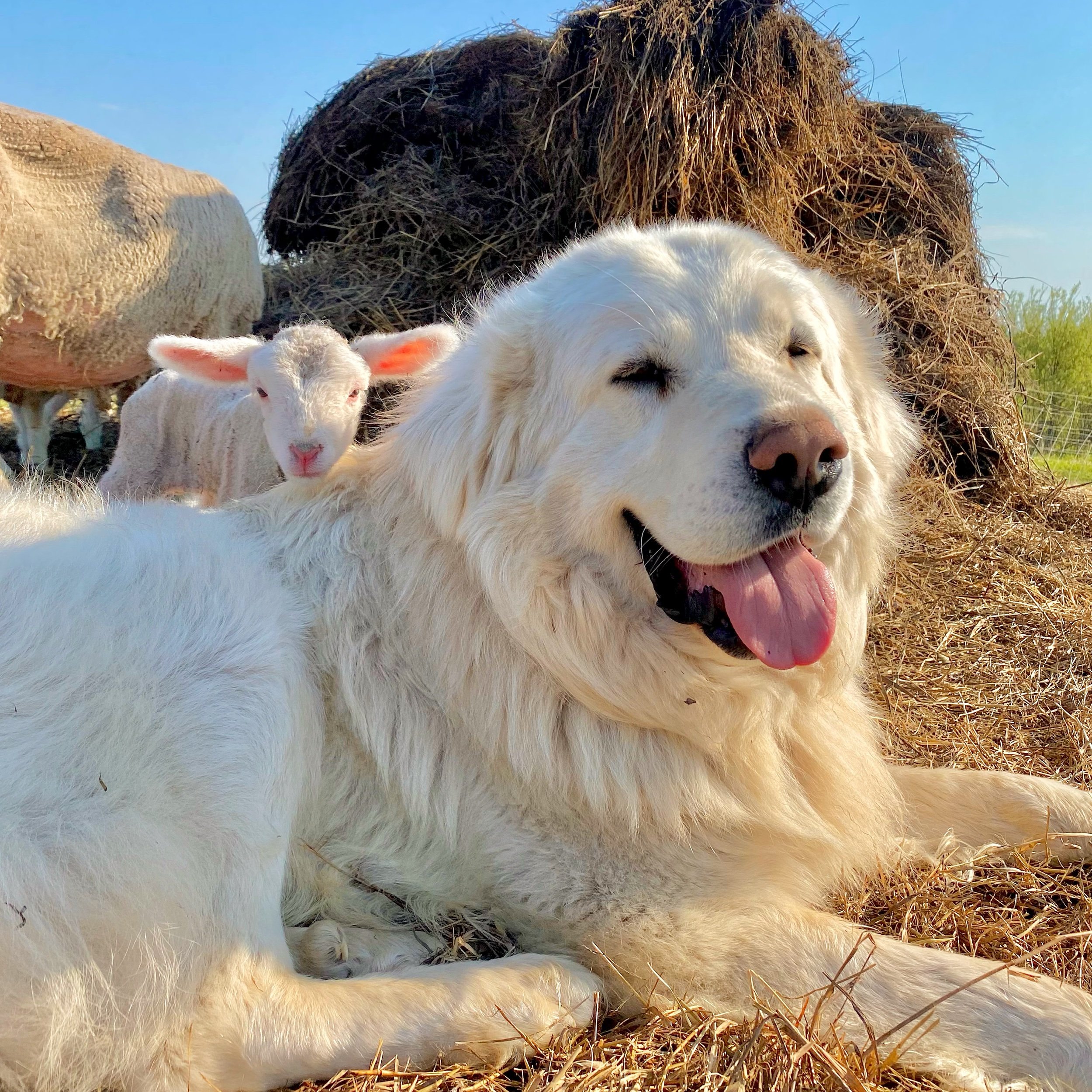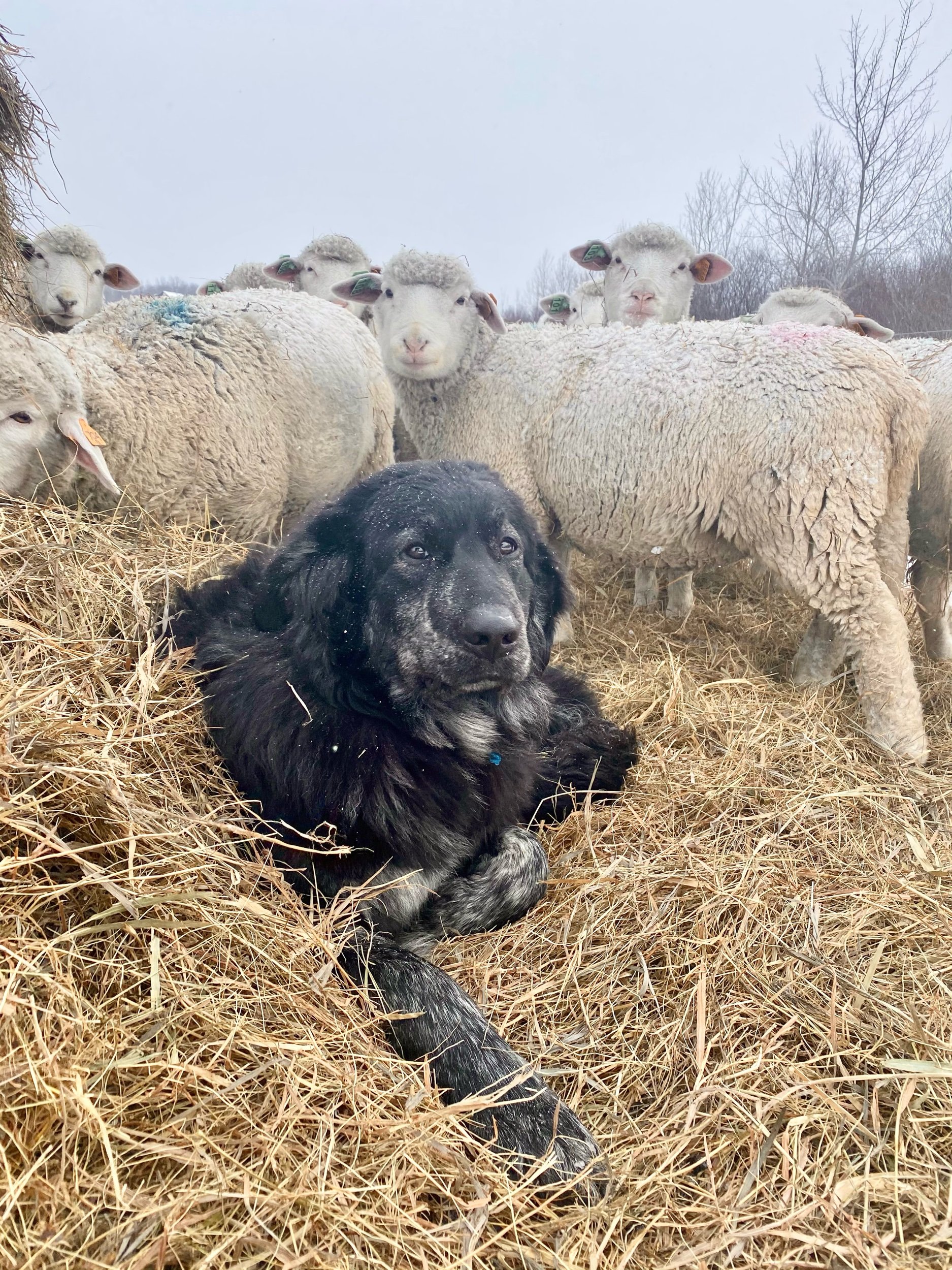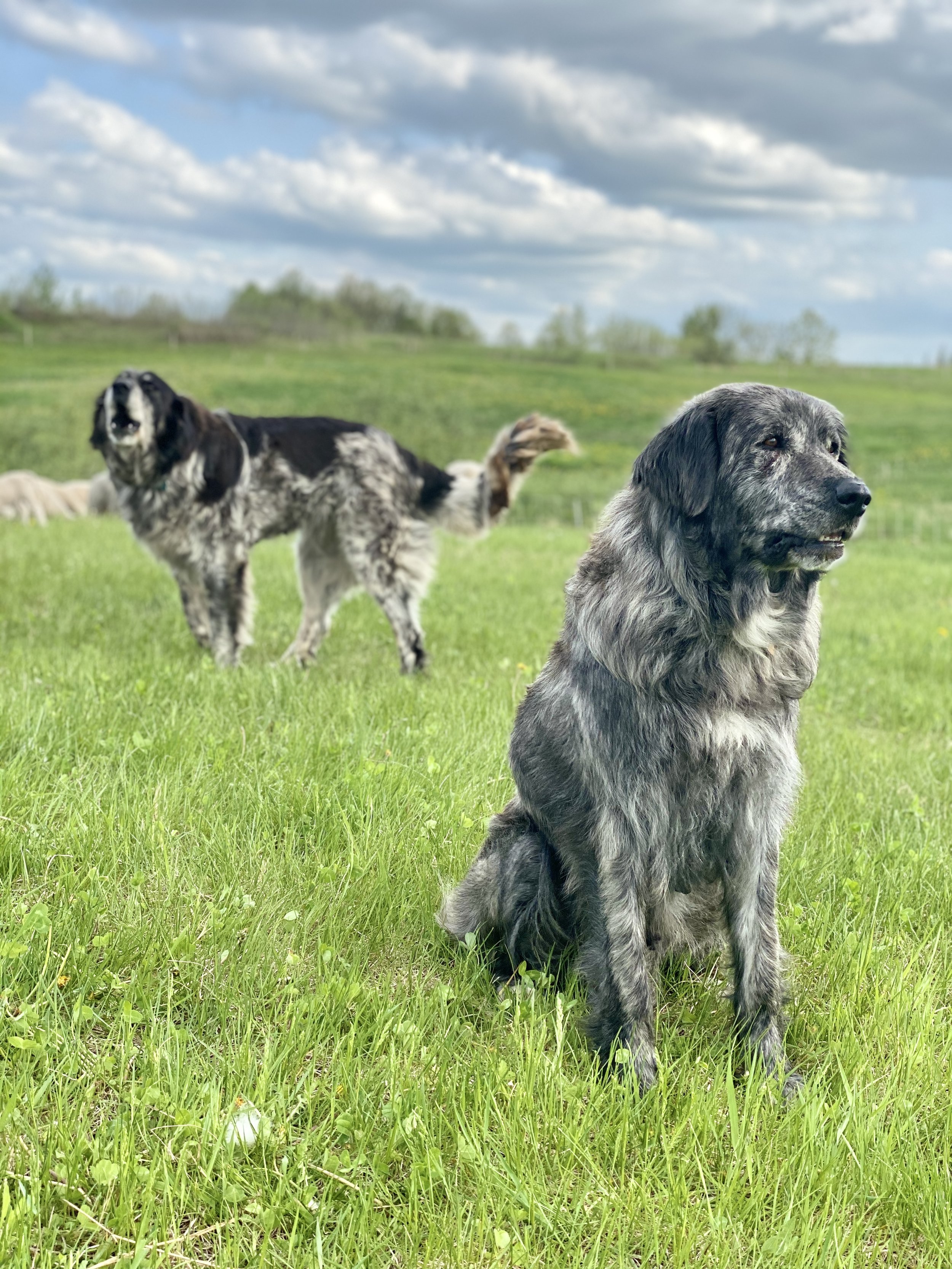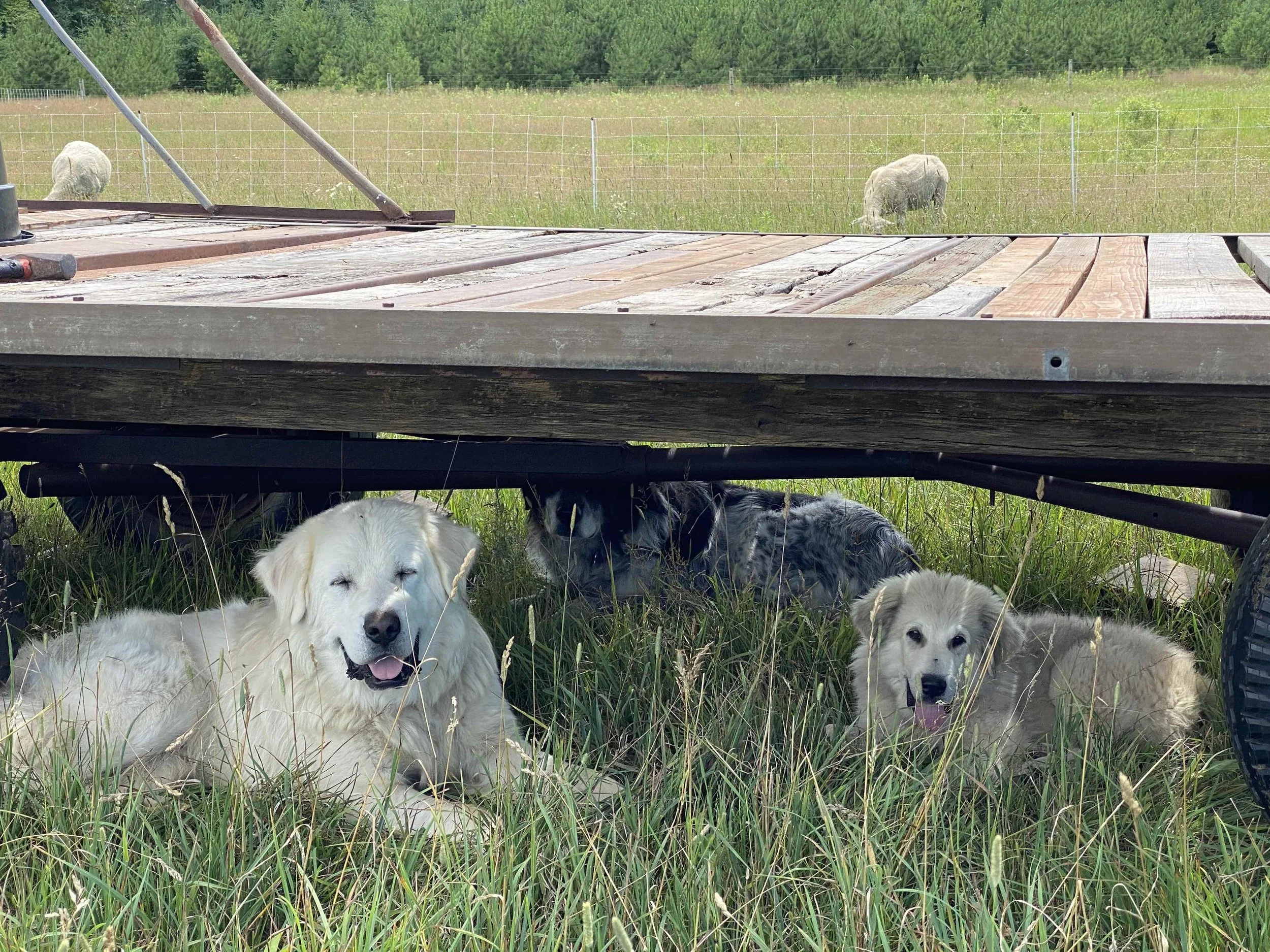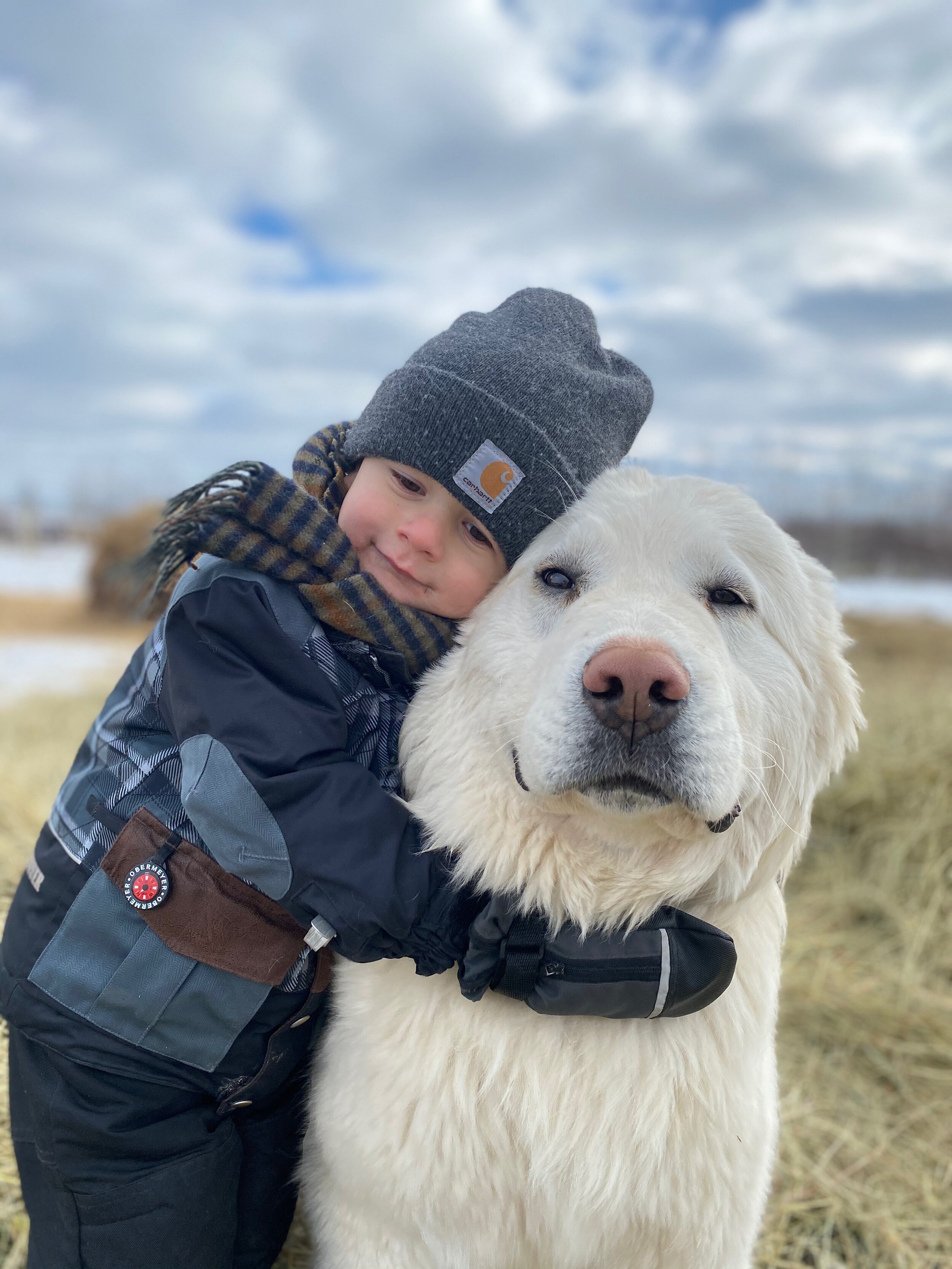livestock guardian dog puppies
We have raised livestock guardian dog puppies from proven working dogs for several years, but are currently taking a break from breeding while we train our border collie.
Our dogs guard our flock of 50 sheep from coyotes, wolves, black bear, bobcats, and cougars here in Northeastern Minnesota.
Our sheep lamb on pasture in May and rotationally graze with daily moves in the summer and fall. We do not have a barn, and our dogs protect our sheep outdoors 24/7 every day of the year.
The dogs are a cross of Maremma, Spanish Mastiff, Polish Tatra & Central Asian Shepherd, from breeding lines developed by Janet McNally at Tamarack Lamb and Wool.
These beautiful dogs are serious about their job and need the right environment to thrive and be happy, and it takes a lot of work to find each puppy the right match for the right job, farm, and family.
While we are not currently placing puppies with new homes, we are happy to share what we have learned about raising livestock guardian dogs over the years as you begin your own search.
Frequently Asked Questions
There are many different opinions and philosophies about raising livestock guardian dogs, and I always recommend doing a lot of research of your own before deciding to purchase one. The below information is based on my own opinion and experience and those of my mentors.
Q: Should I get a livestock guardian dog as a family pet?
A: Some guard dogs make successful family pets or “yard guards,” but we prioritize placing our puppies with working farms who already have livestock. I don’t advise getting a guard dog if you live in a city or suburb, even if you spend a lot of time outside being active, as I don’t believe it’s in the best interests of the dog.
Q: What breed of livestock guardian dog should I get?
A: This may depend a lot on what kind of situation you’re raising your livestock in. Most people are familiar with big white livestock guardian dogs like the Great Pyrenees. I often describe Maremmas as “the Italian version of a Great Pyrenees” because they look a lot alike; however, their guarding traits are quite different. In many European areas, shepherds practiced transhumance, moving the whole flock into protected lowlands for the winter but letting them free range high in the mountains over large swaths of land during the summer. The Great Pyrenees was bred to protect these sheep and as such, have a strong instinct to patrol large areas. They are quite active with a lot of energy and the need to run. This can be a great fit if you practice continuous grazing of one very large pasture, your livestock graze open range lands as is common in the West, or you are surrounded by large areas of wildnerness. They are typically not recommended for smaller acreages or homesteads where neighbors are close by.
Maremmas, on the other hand, were bred to protect sheep in the plains and marshlands of Italy. These flocks were often dairy sheep who went out to pasture during the day, but were brought into a farm yard for milking each day. These dogs were expected to stick with the sheep when they moved and had smaller areas to protect. Similarly, Polish Tatra (which look a lot like the Maremma) are close-guarding dogs who tend to round up their sheep when a threat is near, keeping them safe by bunching the flock together in tight formation. Meanwhile, our Spanish Mastiff lines also descend from sheep dairies in Spain bred for their close-guarding instincts (and this is where the dark coloring in some of our dogs comes from). While Central Asian Shepherds come from more nomadic shepherding traditions, they also tend to be close-guarding and were bred to be extremely responsive and loyal to the shepherd and excellent with children. We have found these traits to be ideal for rotational grazing on our 160 acre farm, with numerous close neighbors and recreational hunting on adjacent properties.
Q: What do I need to do to train a livestock guardian dog?
A: Livestock guardian dogs have been bred to work by instinct. They will naturally want to protect whatever is in their charge. However, it’s important to bond the puppy to the livestock at a young age, and it will be your job to set the dog up for success and correct any play behaviors with the livestock when the dog is still a puppy. You can expect the dog to be a trustworthy guardian by 2 years of age if given the proper guidance and supervision.
One way to train a guard puppy is to keep it in a pen with “nanny” ewes — older ewes who won’t tolerate puppy play but are not too aggressive like a ram which may end up hurting the pup. This is generally quite effective, but from a management standpoint can be more difficult if you do not want to feedlot any animals during the grazing season.
The way we raise our pups is to create a mobile pen out of two hog panels clipped together. The pen is kept inside the same paddock with the sheep and moved every time the sheep move. When I am with the sheep daily the puppy is allowed out of the pen to interact with the sheep while I am able to supervise. My training consists of verbal praise for walking calmly among the sheep and gently licking tails or noses, and scolding if the puppy scares the sheep or tries to play with them.
By around 4 months I allow the puppy outside of the pen without me, but typically this is the height of summer (hot weather deters play behavior) and there are always other adult dogs with the puppy that it is learning from. If you do not have other adult dogs, you may want to continue penning, using a stake and chain, or create a temporary paddock adjacent to the livestock just for the puppy where it has more room. The goal is for the puppy to always be with the livestock so it learns that “home” is with the livestock. If a puppy ever escapes or wanders away from the livestock, I correct with a stern “go home” while pointing to the sheep.
It’s also generally advisable to do some basic training for walking on a leash and riding in a car so you are able to take the puppy to the vet when necessary. Exposure to any other normal and routine happenings on your farm that you would prefer the puppy to not bark at can also be helpful.
I personally also recommend early exposure to children and family members, but those interactions should always happen in the pen or paddock with the livestock. If the puppy is allowed to come to the farm yard to socialize with humans, the dog may choose to bond with humans instead of the animals and will not be reliable to stay with the animals.
When cooler weather returns and/or the puppy reaches adolescence, additional training, observation, and correction will likely be necessary. You may need to remove the puppy from having direct interaction with the livestock again for a time (but again, always keep them adjacent to the livestock). Other sensitive times are the puppy’s first breeding season and the puppy’s first lambing season. Rams have been known to pick fights with puppies, and the novelty of ram breeding behavior can instigate curiosity and play behavior.
Likewise, puppies should not be left alone with lambing ewes, although typically an LGD is more likely to try to steal away and nanny newborns than hurt them. You will want to introduce the lambing process to the puppy only under your close supervision. You can allow the dog to smell and lick newborn lambs, praising gentle behavior, but scolding if they interfere with letting the ewe have access to the lamb. When there are many bouncing lambs running around a pasture, this is when any play or chase needs to be immediately corrected. It’s also important to give positive reinforcement when the puppy walks calmly among the flock, gently licks ears or tails, or ignores a lamb running by.
Q: Do the dogs bark a lot?
A: Yes. Livestock guardian dogs are primarily a predator deterrent. It’s typically quite rare for a guard dog to get into a direct confrontation with a wolf or coyote, although it does happen. The way the dogs protect livestock is by alert barking at anything they see, smell, or hear that is not typically in their environment, and predators usually choose to avoid territory that appears to be occupied by a guard dog. They are also quite nocturnal, as most predators choose to hunt at night, and your dog will likely spend most of the day sleeping.
One of the reasons we do not recommend livestock guardian dogs for farms smaller than 10 acres is that nocturnal barking would likely be happening close to your house or your neighbor’s house. Most livestock guardian dogs needing to be re-homed come from first-time LGD owners who were not prepared to have their sleep interrupted or had conflict with their neighbors.
That said, our dogs do not nuisance bark at anything and everything. If they are barking they have a good reason to, and they stop when the threat has passed.
Q: What kind of fence do I need?
A: While the puppy is young (under 4 months or so), I recommend a secure metal pen of some sort. When a little bigger, a puppy can quickly be trained to a hot electronet fence. This will typically keep a puppy contained until fully grown. I do recommend at least a five strand high tensile electric perimeter fence for pastures your dog will guard; while this is not fool proof, it does seem to give the dog some sense of boundaries.
That said, all our fully-grown dogs can, and do, jump fences in their guarding duties. But once they reach adulthood, we trust their judgment and know they always return to their sheep once a threat has passed. While our dogs willingly choose to stay with the sheep the majority of the time, we do know they sometimes patrol at night, usually with most of the dogs staying with the sheep while two dogs circle wider out or track a scent; however, they have naturally figured out the boundaries of our property based on fence lines and where we graze, and do not venture farther out. If a dog feels the need to pursue a threat, no fence will stop them, but typically our LGDs will only chase a predator out of its territory and then retreat.
When it comes to puppies and adolescents, containing an LGD is more important. Teenagers especially are liable to get into trouble (dig up carcasses, wander onto neighbors’ property, chase the UPS man up the lane). If necessary, this is another time when penning or chaining the dog is advised, but these behaviors usually resolve by 2 years old. I also find they are lessened when there is more than one adult dog modeling good behavior for them.
Q: Can LGDs be bonded to livestock other than sheep?
A: Yes. Our dogs have successfully guarded cattle and poultry in addition to small ruminants. The important thing is to bond the dog to the livestock you’d like it guard as soon as possible. Different management strategies may be required to protect the puppy from larger livestock or alternatively protect smaller livestock from the puppy; but in general the same principles apply. The dog’s personality may play a larger part in successfully bonding it to different species, and in general it seems that poultry require a calmer, more laid-back demeanor while cattle may require a more submissive dog.
All that said, please understand that it is generally much more difficult to bond a puppy to poultry than to sheep, and a puppy is less likely to be automatically submissive to livestock smaller than they are, which makes training more difficult. If you are selecting an LGD puppy specifically for your backyard flock, do not expect to drop the puppy with the flock and walk away. It will take more training, attention, and persistence, and you should be prepared for frustrations and set backs.
In many cases, trustworthy older dogs who are slowing down some can make a good fit with other species and might be able to be transitioned to other livestock, particularly poultry.
Q: What kind of shelter does a guard dog need?
A: Our livestock guardian dogs have a thick double coat that makes them perfectly suited to winter weather and temperatures. Most guard dogs prefer winter to summer, and will not willingly go inside a dog house at night as they are not able to see and hear well enough to do their job guarding. It’s quite common for guard dogs to sleep perched high on a hay bale or the highest point in the pasture so they can better see their surroundings. Hay bedding and a wind break is generally all they need in the winter. If you are in a climate with frequent freezing rain, you’ll want to give the dog access to an overhead shelter, but they will likely prefer open-sided structures to fully enclosed ones.
While our dogs shed out their undercoat in the summer (brushing to help this process is usually necessary), your dog will need access to shade in summer. We use a hay wagon for mobile shade, and also created two very basic wooden lean-to structures that fit inside the puppy pens and can also be easily moved.
Q: How many livestock guardian dogs do I need?
A: This depends on your predator pressure. If you haven’t had any losses yet and your predators are mostly small, starting with one will definitely help to keep your livestock safe. If you have had coyote losses already or have a high coyote population, you likely need to have at least two adults working together. If you are in active wolf territory, it’s recommended to keep at least four adult LGDs to keep a wolf pack from wanting to engage.
Q: Should I get two puppies at once?
There are many different opinions on this topic, but in general I think it makes the most sense to raise one puppy at a time so they are not the same age. Two puppies, especially from the same litter, may be more inclined to bond to each other than the livestock. While they make good play mates for each other—which could potentially keep them from playing with the livestock—it could also lead to a snowballing of bad behavior and ganging up on livestock. But if you have predator losses and can’t find adult dogs, you may want to get two pups at the same time. In this instance, I would suggest keeping the puppies apart with separate groups of livestock as much as possible until adulthood.
Q: Do you sell adult dogs? Where can I find an adult dog?
A: Our puppies are raised with the livestock from the time they are old enough to be outside so they have early imprinting and bonding, but due to the time and cost of raising a dog to adulthood, we do not sell adult dogs that have already been trained. I am occasionally contacted by farmers looking to re-home an adult LGD, so if you indicate your interest in an adult dog on the form above, I will reach out regarding any that I hear become available. I have encountered many reasons why dogs need to be re-homed from owner death to job changes to upset neighbors, so it is not always an indication that there is something wrong with the dog. I also recommend looking at the “LGD Finder” Facebook Page although there are strict rules about animal sales so please read the group rules before posting.
Q: Should I get a male or a female?
A: Most experts agree there is no distinguishable difference between the guarding instincts of male and female guard dogs, and there is more difference between individual personalities than between sexes. If you plan to keep your dogs intact, you may find that males are more likely to be distracted or leave the flock when a female is in heat nearby. Otherwise, we recommend basing sex decisions on the other dogs on your farm. Opposite sex dogs are more likely to get along, and we recommend getting both a male and female if you are planning to keep a guarding pair working together.
Q: Are the dogs safe with children, the elderly, or strangers?
A: Puppies are puppies; be prepared for jumping and chewing when young, and plan to keep children and the elderly safe from enthusiastic 60+ pound 7 month old puppies. Once adults, our LGD personalities are slightly aloof and independent-minded, but tend to greet trusted humans and seek their affection before returning to their flock.
It’s always recommended to accompany visitors when meeting an LGD. All strangers will be barked at, but some dogs are more quickly accepting of strangers than others which is usually dependent on individual personality. Your presence will help assure that the stranger can be trusted, but ultimately the dog will decide whether or not to greet the stranger with you. If the puppy is socialized to visitors when young, it will be more accepting of visitors as an adult.
Additionally, if the LGD is highly socialized to your children, it’s possible the dog considers your children under its protection as well. In these cases, it’s wise to make sure any visiting children do not play with your child near the LGD in case the dog misinterprets any squealing and yelling as your child being harmed.
These are large, powerful dogs; while not inherently dangerous, know your dog and its personality and do not put it in a situation it will find overly stressful.
Q: Should I get a bigger or a smaller breed/dog?
A: You will probably want your dog to be bigger than your biggest predator. That said, bigger is not always better, especially when it comes to your dog food bill.
our breeding dogs
Here is historical information about our breeding dogs.
Griffin
Griffin is the sire of our puppies. He is a Maremma, Spanish Mastiff, Polish Tatra, and Central Asian Shepherd cross.
He comes from Janet McNally’s farm, out of her female LGD named Grr. He is 120 pounds.
Griffin is an extremely good listener and has a warm and affectionate personality. He watches over lambing closely and somehow knows to protect newborn lambs and mothers from nanny ewes who try to interfere.
Shadow
Shadow is a Spanish Mastiff, Polish Tatra, and Maremma cross.
Small and agile for an LGD, she weighs just under 100 pounds. She also comes directly from Janet McNally’s breeding lines.
She is an extremely close guarding and doting dog, keeping her sheep in tight formation when a potential threat is near, and rounding up any lambs who slip under a fence wire to shoo them back in her paddock where she knows they belong.
She is uneasy with strangers and has an energetic personality that melts when her trusted humans give her attention.
Lena
Lena is also Spanish Mastiff, Polish Tatra, and Maremma and weighs approximately 105 pounds.
She is a descendent from Janet McNally’s breeding lines but was born on another sheep farm. She made several successful transitions between farms—adapting to goats and milking routines at one point—before luck brought her to us.
Lena is also close guarding, and never leaves her sheep except to inform me when something’s wrong. She has alerted me to a lamb buried under a toppled hay bale (it survived thanks to her!) and refused to leave a pasture until I realized a lamb had gotten separated from the flock and lost its way there.
She is incredibly submissive and easygoing with trusted humans but wary of strangers.
Our cost per puppy is $600. They are sold with a written health and performance guarantee and will be weaned and dewormed, but are not available to just anyone. They are not recommended for small acreages or situations where barking dogs are likely to bother neighbors.
In return for our guarantee, we ask that buyers keep in touch regarding their puppy, especially if they have any concerns or have never raised a guard dog puppy before. Many problems can be averted with simple management changes.
We perform puppy assessment tests at 6 weeks to gather information on personality and temperament. If you would like to be considered for a potential match, please complete the form below to tell us more about your livestock guarding needs and what you are looking for in a dog.
We do currently have a considerable wait list, but many factors go into finding a good match. If we are not able to place a puppy with you right away, please indicate if you’d like to remain on the wait list for future matches.
If you are new to owning a livestock guardian dog, please see the Frequently Asked Questions section below before completing the form.


